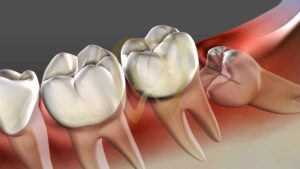The Enigmatic Wisdom Teeth
Wisdom teeth, also known as third molars, are the last set of molars to emerge in the human mouth. They typically appear during the late teens or early twenties, often causing excitement and concern among individuals. These teeth have been a topic of intrigue for dental professionals and patients alike, particularly when it comes to their roots and their implications for oral health.
In this informative article, we will delve deep into the world of wisdom teeth and explore the mysteries surrounding their roots. From understanding their formation to discussing common dental issues, we will provide you with valuable insights into the fascinating aspects of wisdom teeth.
How Many Roots Do Wisdom Teeth Have?
One of the primary questions that often arise when discussing wisdom teeth is the number of roots they possess. Wisdom teeth can have either two or three roots, which is one of the factors that differentiate them from other molars in the mouth. The number of roots may vary from person to person, and it is essential to comprehend their structure to understand potential dental complications.
The Formation of Wisdom Teeth and Their Roots
The development of wisdom teeth begins during early adolescence when the tooth buds form in the jawbone. As these teeth progress in growth, they start to develop roots that anchor them in the jaw. While some individuals may have all four wisdom teeth, others may have only one or two, and some may not have them at all.
Understanding the Purpose of Wisdom Teeth Roots
Wisdom teeth roots play a crucial role in supporting the teeth and stabilizing them within the jaw. The strength and positioning of the roots help in proper chewing and grinding of food, contributing to the digestive process. Moreover, the roots provide structural support to adjacent teeth and the jawbone.
Wisdom Teeth Root Development
The development of wisdom teeth roots is an intricate process influenced by various factors such as genetics, jaw size, and oral hygiene. Understanding this development can help anticipate potential issues and take preventive measures.

The Link Between Wisdom Teeth Roots and Dental Problems
While wisdom teeth can be beneficial, they can also lead to several dental issues due to their late emergence and limited space in the jaw. Some common problems associated with wisdom teeth roots include:
1. Impaction: Wisdom teeth may not have enough room to emerge fully, causing them to become impacted in the gums or jawbone. This can lead to pain, swelling, and an increased risk of infection.
2. Crowding: When wisdom teeth erupt, they can push against neighboring teeth, causing crowding and misalignment issues.
3. Infections and Gum Disease: Partially erupted wisdom teeth can create pockets around them, promoting bacterial growth and leading to gum infections and gum disease.
4. Cysts and Tumors: In rare cases, wisdom teeth development can lead to the formation of cysts or tumors, which may damage the jawbone or surrounding teeth.
Treating Wisdom Teeth Root-Related Issues
When wisdom teeth root-related issues occur, dental professionals may recommend various treatment options based on the severity of the problem. Some common approaches include:
Extraction: When wisdom teeth cause significant discomfort or pose a risk of complications, extraction may be necessary. Extraction can help prevent crowding and alleviate pain.
Surgical Removal: Impacted wisdom teeth may require surgical removal, especially when they are deeply embedded in the jawbone.
Antibiotics and Pain Management: In cases of infection, antibiotics may be prescribed, and pain management techniques can help ease discomfort.
FAQs About Wisdom Teeth Roots
1. Are all wisdom teeth roots the same?
No, the number of roots in wisdom teeth can vary. Some have two roots, while others may have three.
2. What happens if I don’t have enough space for my wisdom teeth to emerge?
If there is insufficient space for wisdom teeth to erupt, they may become impacted, leading to pain and potential complications.
3. Can wisdom teeth roots damage adjacent teeth?
Yes, wisdom teeth roots can exert pressure on neighboring teeth, causing crowding and misalignment.
4. How do dentists determine if wisdom teeth need to be extracted?
Dentists assess wisdom teeth through X-rays and clinical examinations to determine if extraction is necessary.
5. Is wisdom teeth removal a painful procedure?
Wisdom teeth removal is typically performed under local anesthesia, ensuring minimal pain during the procedure.
6. Are there any risks associated with wisdom teeth extraction?
Like any surgical procedure, wisdom teeth extraction carries some risks, such as infection or excessive bleeding. However, these are rare.
Navigating the World of Wisdom Teeth Roots
In conclusion, wisdom teeth are intriguing dental marvels that have both benefits and challenges associated with their roots. Understanding how many roots wisdom teeth have and their potential impact on oral health is essential for maintaining a healthy smile.
Whether you’re experiencing wisdom teeth-related issues or are curious about their development, consulting with a dental professional can provide valuable guidance. Remember, proper oral care and regular dental check-ups are vital in ensuring your wisdom teeth and overall oral health stay in excellent condition.



